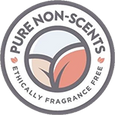Fragrance-Free or Unscented?
Fragrance is everywhere! Even if you don’t wear perfume, you’re probably bathing, washing your dishes, laundry and cleaning your home with fragrance-filled products. Products labelled unscented or fragrance-free might still expose you to the same irritating ingredients. How is that possible you ask? Well, the terms “Fragrance-Free” and “Unscented” are not backed by a legal definition or FDA regulations. So, it is up to the manufacturer to decide what those words mean in their products.
There are many concerns regarding fragrances, aside from the clear red flag reactions like red, and itchy skin or rash. There are many more concerns about the long-term use of fragrances and their absorption into the skin leading many to avoid the ingredients altogether.
Decoding Fragrance-Free and Unscented
Unfortunately, skipping scent is easier said than done. In some cases, products labelled “unscented” may still contain fragrance not to create a scent but to mask a strong odour caused by the formula composition. According to the American Academy of Dermatology, “Fragrance-free,” on the other hand, can mean that no extra fragrances were added to change the product’s naturally occurring aroma. So, the product still may have a scent and contain fragrant and irritating ingredients otherwise considered safe in the formula.
To make matters worse, some brands sneakily stretch these definitions even further: “I’ve seen companies who said their products were “fragrance-free” then listed the fragrance components like linalool, citronellol, and citral on the label separately,” says New Jersey-based cosmetic chemist Ni’Kita Wilson.
However, very few manufacturers and products claiming to be fragrance-free or unscented actually are. Pure Non-Scents is one of those few manufacturers and promotes ethically fragrance-free hair & skincare!
How To Tell What’s Really In Your Products
How can you tell if a product has potentially irritating fragrances? Well, the easiest answer is to read the complete ingredient list on your product. Check the label for “fragrance” or any ingredients unfamiliar to you that could be masquerading their purpose.
If that fails give your product a sniff. If it smells like strawberries, coconuts or any synthetic or perfume-like scent you don’t need a label to tell you it has fragrance in it and to avoid it. If you can’t smell a thing, put it to the final test.
Check the label for sneaky fragrance names. According to the European Commission’s Scientific Committee on Consumer Safety, the following 26 fragrance chemicals are the ones you need to screen the label for. If the product in question is free of the following 26 ingredients, it’s earned a place in your medicine cabinet. Too complicated? Download these phone apps that read product labels for you: Yuka, ThinkDirty, and INCI Beauty.
- Oakmoss Extract
- Tree moss Extract
- Benzyl alcohol
- Cinnamyl alcohol
- Citral
- Eugenol
- Hydroxy-citronellal
- Isoeugenol
- Amylcinnamyl Alcohol
- Benzyl Salicylate
- Cinnamal
- Coumarin
- Geraniol
- Anisyl alcohol
- Benzyl cinnamate
- Farnesol
- Linalool
- Benzyl benzoate
- Citronellol
- Hexyl cinnamaldehyde
- d-Limonene
- Methyl heptine carbonate
- 2-(4-tert-butylbenzyl)propionaldehyde
- 3-Methyl-4-(2,6,6-trimethyl-2-cyclohexen-1-yl)-3-buten-2-one
- Hydroxymethylpentylcyclohexenecarboxaldehyde
Unfortunately, the above ingredients may not be listed on your product contemplation but instead, the manufacturers are legally obliged to only state on the label the words fragrance/parfum. Quite unfortunate, especially if you have sensitive skin or other skin disorders. Pure Non-Scents could be the solution!

